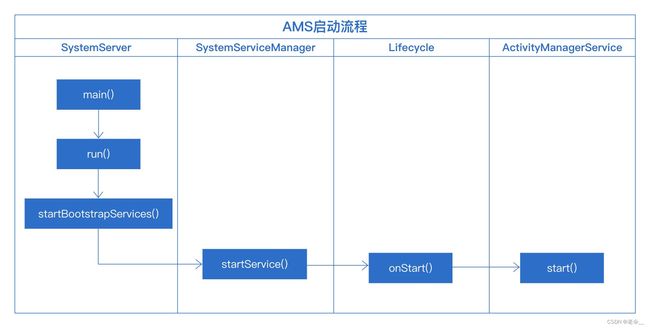#Janus# 安卓系统启动流程之《AMS 启动流程》
最近学习系统启动流程,这里对于AMS是如何启动的过程做一个输出,基于安卓源码8.0版本。
AMS的介绍就不多说了,百度一大堆,下面直接上过程:
SystemServer.class 中main方法里,调用了SystemServer的run()方法
/**
* The main entry point from zygote.
*/
public static void main(String[] args) {
new SystemServer().run();
}
看一下run()方法里做了什么:
private void run() {
try {
traceBeginAndSlog("InitBeforeStartServices");
if (System.currentTimeMillis() < EARLIEST_SUPPORTED_TIME) {
Slog.w(TAG, "System clock is before 1970; setting to 1970.");
SystemClock.setCurrentTimeMillis(EARLIEST_SUPPORTED_TIME);
}
String timezoneProperty = SystemProperties.get("persist.sys.timezone");
if (timezoneProperty == null || timezoneProperty.isEmpty()) {
Slog.w(TAG, "Timezone not set; setting to GMT.");
SystemProperties.set("persist.sys.timezone", "GMT");
}
if (!SystemProperties.get("persist.sys.language").isEmpty()) {
final String languageTag = Locale.getDefault().toLanguageTag();
SystemProperties.set("persist.sys.locale", languageTag);
SystemProperties.set("persist.sys.language", "");
SystemProperties.set("persist.sys.country", "");
SystemProperties.set("persist.sys.localevar", "");
}
Binder.setWarnOnBlocking(true);
Slog.i(TAG, "Entered the Android system server!");
int uptimeMillis = (int) SystemClock.elapsedRealtime();
EventLog.writeEvent(EventLogTags.BOOT_PROGRESS_SYSTEM_RUN, uptimeMillis);
if (!mRuntimeRestart) {
MetricsLogger.histogram(null, "boot_system_server_init", uptimeMillis);
}
SystemProperties.set("persist.sys.dalvik.vm.lib.2", VMRuntime.getRuntime().vmLibrary());
VMRuntime.getRuntime().clearGrowthLimit();
VMRuntime.getRuntime().setTargetHeapUtilization(0.8f);
Build.ensureFingerprintProperty();
Environment.setUserRequired(true);
BaseBundle.setShouldDefuse(true);
BinderInternal.disableBackgroundScheduling(true);
BinderInternal.setMaxThreads(sMaxBinderThreads);
android.os.Process.setThreadPriority(
android.os.Process.THREAD_PRIORITY_FOREGROUND);
android.os.Process.setCanSelfBackground(false);
Looper.prepareMainLooper();
System.loadLibrary("android_servers");
performPendingShutdown();
createSystemContext();
mSystemServiceManager = new SystemServiceManager(mSystemContext);
mSystemServiceManager.setRuntimeRestarted(mRuntimeRestart);
LocalServices.addService(SystemServiceManager.class, mSystemServiceManager);
SystemServerInitThreadPool.get();
} finally {
traceEnd(); // InitBeforeStartServices
}
// ① 重点在这里,这里启动了各种系统服务,我们关注的AMS,也是由 startBootstrapServices(); 方法启动的。
try {
traceBeginAndSlog("StartServices");
startBootstrapServices();
startCoreServices();
startOtherServices();
SystemServerInitThreadPool.shutdown();
} catch (Throwable ex) {
Slog.e("System", "******************************************");
Slog.e("System", "************ Failure starting system services", ex);
throw ex;
} finally {
traceEnd();
}
if (StrictMode.conditionallyEnableDebugLogging()) {
Slog.i(TAG, "Enabled StrictMode for system server main thread.");
}
if (!mRuntimeRestart && !isFirstBootOrUpgrade()) {
int uptimeMillis = (int) SystemClock.elapsedRealtime();
MetricsLogger.histogram(null, "boot_system_server_ready", uptimeMillis);
final int MAX_UPTIME_MILLIS = 60 * 1000;
if (uptimeMillis > MAX_UPTIME_MILLIS) {
Slog.wtf(SYSTEM_SERVER_TIMING_TAG,
"SystemServer init took too long. uptimeMillis=" + uptimeMillis);
}
}
// Loop forever.
Looper.loop();
throw new RuntimeException("Main thread loop unexpectedly exited");
}
在注释①的位置,就是启动各种服务方法,在startBootstrapServices()中启动了ActivityManagerService,继续往下看:
private void startBootstrapServices() {
…//多余代码删除
// Activity manager runs the show.
traceBeginAndSlog("StartActivityManager");
mActivityManagerService = mSystemServiceManager.startService(ActivityManagerService.Lifecycle.class).getService();
mActivityManagerService.setSystemServiceManager(mSystemServiceManager);
mActivityManagerService.setInstaller(installer);
traceEnd();
…//多余代码删除
}
首先先看这一行代码
mActivityManagerService = mSystemServiceManager.startService(ActivityManagerService.Lifecycle.class).getService();
这里调用了mSystemServiceManager.startService()方法,并且传入了一个ActivityManagerService.Lifecycle.class作为参数,然后再调用getService()方法获取到AMS对象;
这里有三个问题:
第一、ActivityManagerService.Lifecycle.class是什么?
第二、mSystemServiceManager是谁?
第三、 mSystemServiceManager.startService里做了什么?
首先第一个问题,ActivityManagerService.Lifecycle.class是什么呢?我们先点进去看他的代码:
public class ActivityManagerService extends IActivityManager.Stub
implements Watchdog.Monitor, BatteryStatsImpl.BatteryCallback {
…//省略多余代码
public static final class Lifecycle extends SystemService {
private final ActivityManagerService mService;
public Lifecycle(Context context) {
super(context);
mService = new ActivityManagerService(context);
}
@Override
public void onStart() {
mService.start();
}
public ActivityManagerService getService() {
return mService;
}
}
…//省略多余代码
}
从代码中来看,他是ActivityManagerService内部的一个静态内部类,继承了SystemService,在其内部构造方法中初始化了ActivityManagerService的实例,而且onStart()方法中调用了AMS的start()方法,getService()方法返回了AMS的实例。
那么我们大胆推测,这个Lifecycle,就是用来获取AMS实例对象并且启动AMS的包装类!现在我们知道谁来启动AMS了,那么启动方法是在哪里调用的呢?
带着疑问我们先继续看第二个问题,mSystemServiceManager又是什么呢?继续看代码
/**
* All system services
*/
SystemServiceManager mSystemServiceManager;
mSystemServiceManager是SystemServiceManager,他主要的作用就是管理SystemService系统服务的创建、启动和其他生命周期事件。
继续第三个问题,startService()方法中做了什么:
我们进入它的startService()方法中看一下,同名方法有很多,我们上面的代码中参数传入的是一个class,并且我们已经知道ActivityManagerService.Lifecycle继承了SystemService,所以我们应该查看这个带泛型并且参数为class的方法
@SuppressWarnings("unchecked")
public T startService(Class serviceClass) {
try {
final String name = serviceClass.getName();//①
Slog.i(TAG, "Starting " + name);
Trace.traceBegin(Trace.TRACE_TAG_SYSTEM_SERVER, "StartService " + name);
// Create the service.
if (!SystemService.class.isAssignableFrom(serviceClass)) {
throw new RuntimeException("Failed to create " + name
+ ": service must extend " + SystemService.class.getName());
}
final T service;
try {
Constructor constructor = serviceClass.getConstructor(Context.class);//②
service = constructor.newInstance(mContext);
} catch (InstantiationException ex) {
throw new RuntimeException("Failed to create service " + name
+ ": service could not be instantiated", ex);
} catch (IllegalAccessException ex) {
throw new RuntimeException("Failed to create service " + name
+ ": service must have a public constructor with a Context argument", ex);
} catch (NoSuchMethodException ex) {
throw new RuntimeException("Failed to create service " + name
+ ": service must have a public constructor with a Context argument", ex);
} catch (InvocationTargetException ex) {
throw new RuntimeException("Failed to create service " + name
+ ": service constructor threw an exception", ex);
}
startService(service);
return service;
} finally {
Trace.traceEnd(Trace.TRACE_TAG_SYSTEM_SERVER);
}
}
其实代码中很简单(关注注释①和②),它就是通过反射获取到Lifecycle对象,然后又通过反射方法执行了Lifecycle的构造方法得到了Lifecycle的实例,最后将这个实例作为参数又调用了startService()方法, 继续往下看
查看第三个方法(因为传入的参数是个实例对象,并且是SystemService的子类)
public void startService(@NonNull final SystemService service) {
// Register it.
mServices.add(service);
// Start it.
long time = SystemClock.elapsedRealtime();
try {
service.onStart();
} catch (RuntimeException ex) {
throw new RuntimeException("Failed to start service " + service.getClass().getName()
+ ": onStart threw an exception", ex);
}
warnIfTooLong(SystemClock.elapsedRealtime() - time, service, "onStart");
}
其他内容先不管,看到try catch内,调用了service的onStart()方法,这个service是通过反射获取到的ActivityManagerService.Lifecycle对象,我们再回到之前的代码中看
public static final class Lifecycle extends SystemService {
private final ActivityManagerService mService;
public Lifecycle(Context context) {
super(context);
mService = new ActivityManagerService(context);
}
@Override
public void onStart() {
mService.start();
}
public ActivityManagerService getService() {
return mService;
}
}
看到这是不是一切都明白了?Lifecycle内的onStart方法中调用了AMS的start()方法,start()就是AMS的启动方法,到这里AMS就是被启动了,同时又通过getService()方法获取到了AMS的实例,用来做其他初始化操作。
下面附上AMS启动方法调用流程图,其实整体流程非常简单,而且这也只是Android系统启动流程的非常小的一部分,写这篇也是对自己学习过程的一个记录,接下来会继续总结其他系统组件启动流程~

